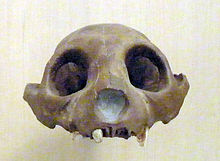Archaeolemur
| Archaeolemur | ||||||||||||
|---|---|---|---|---|---|---|---|---|---|---|---|---|

Live reconstruction of Archaeolemur majori |
||||||||||||
| Systematics | ||||||||||||
|
||||||||||||
| Scientific name | ||||||||||||
| Archaeolemur | ||||||||||||
| Filhol , 1895 |
Archaeolemur is an extinct primate genus thatlivedon the island of Madagascar until around 1000 years ago. Together with Hadropithecus ,which is also extinct, it forms the group of Archaeolemurinae .
Archaeolemur was a relatively large primate, possibly partially living on the ground. His weight is estimated at 15 to 25 kilograms, his skull was 12 to 15 centimeters long. In physique and in the way of life he resembled the baboons . The arms and legs were short and strong, the hands and feet paw-like. There were only two incisors on the lower jaw , the molars were wide and had rounded cusps. Presumably, these animals were omnivores that ate fruits, seeds and small animals.
Archaeolemur is one of the most widespread extinct species of lemur . Two species have been described, A. majori is known from southern Madagascar and A. edwardsi from northern and central Madagascar. There are over 20 sites, the remains are dated to an age of 2800 to 1000 years. Their habitat is likely to have been forests, scrublands and savannas.
Their extinction was probably directly related to the human settlement on their home island 1500 years ago. In the course of this settlement, a number of large animals, including primate species such as the giant lemur , probably became extinct due to hunting and the extensive destruction of their habitat.
literature
- Thomas Geissmann : Comparative Primatology. Springer-Verlag, Berlin et al. 2002, ISBN 3-540-43645-6 .
- Ronald M. Nowak: Walker's Mammals of the World. 6th edition. Johns Hopkins University Press, Baltimore MD 1999, ISBN 0-8018-5789-9 .
Web links
